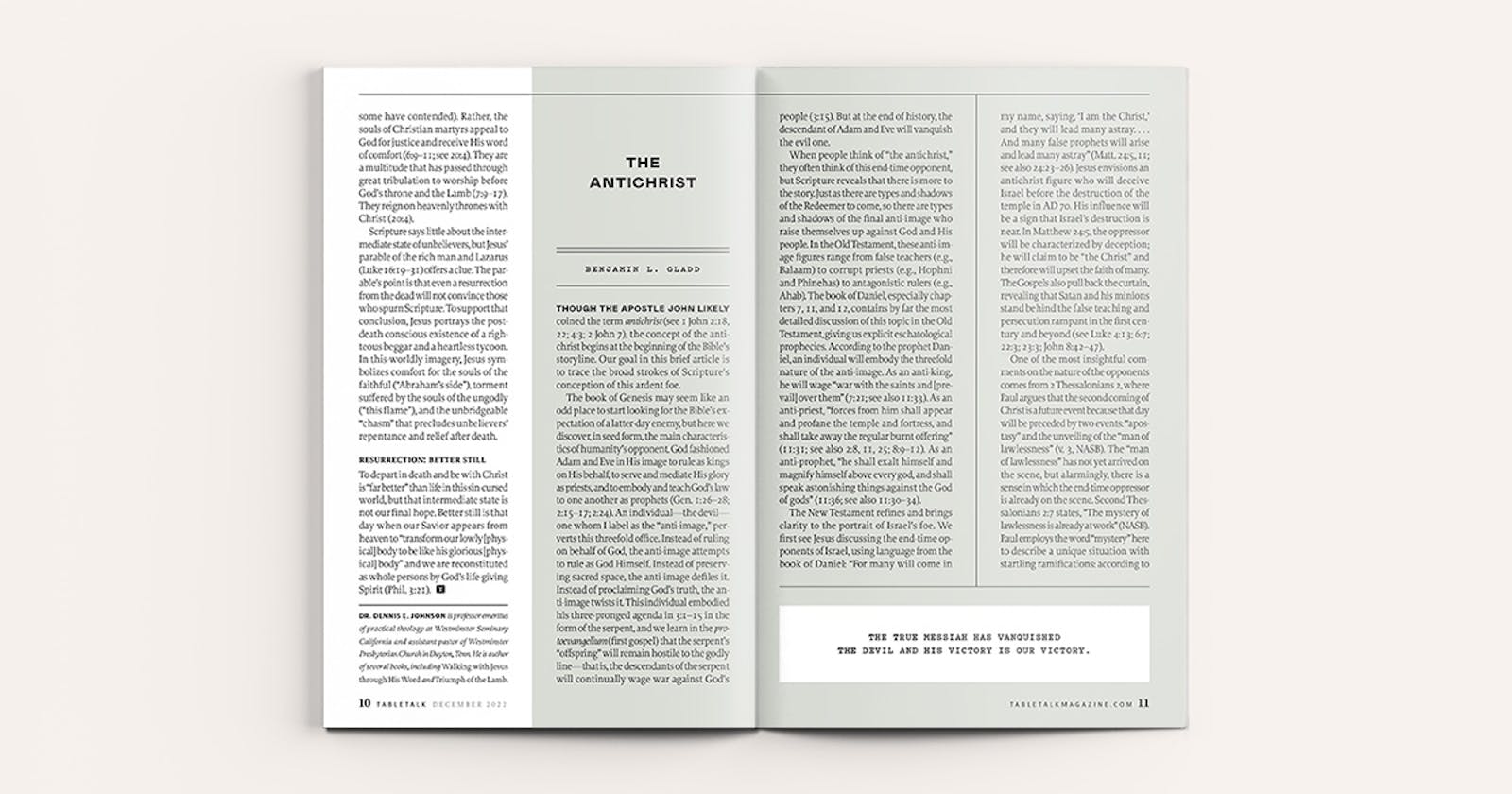
Request your free, three-month trial to Tabletalk magazine. You’ll receive the print issue monthly and gain immediate digital access to decades of archives. This trial is risk-free. No credit card required.
Try Tabletalk NowAlready receive Tabletalk magazine every month?
Verify your email address to gain unlimited access.
Though the Apostle John likely coined the term antichrist (1 John 2:18, 22; 4:3; 2 John 7), the concept of the antichrist begins at the beginning of the Bible’s storyline. Our goal in this brief article is to trace the broad strokes of Scripture’s conception of this ardent foe.
The book of Genesis may seem like an odd place to start looking for the Bible’s expectation of a latter-day enemy, but here we discover, in seed form, the main characteristics of humanity’s opponent. God fashioned Adam and Eve in His image to rule as kings on His behalf, to serve and mediate His glory as priests, and to embody and teach God’s law to one another as prophets (Gen. 1:26–28; 2:15–17; 2:24). An individual—the devil—one whom I label as the “anti-image,” perverts this threefold office. Instead of ruling on behalf of God, the anti-image attempts to rule as God Himself. Instead of preserving sacred space, the anti-image defiles it. Instead of proclaiming God’s truth, the anti-image twists it. This individual embodied his three-pronged agenda in 3:1–15 in the form of the serpent, and we learn in the protoevangelium (first gospel) that the serpent’s “offspring” will remain hostile to the godly line—that is, the descendants of the serpent will continually wage war against God’s people (Gen. 3:15). But at the end of history, the descendant of Adam and Eve will vanquish the evil one.
When people think of “the antichrist,” they often think of this end-time opponent, but Scripture reveals that there is more to the story. Just as there are types and shadows of the Redeemer to come, so there are types and shadows of the final anti-image who raise themselves up against God and His people. In the Old Testament, these anti-image figures range from false teachers (e.g., Balaam) to corrupt priests (e.g., Hophni and Phinehas) to antagonistic rulers (e.g., Ahab). The book of Daniel, especially chapters 7, 11, and 12, contains by far the most detailed discussion of this topic in the Old Testament, giving us explicit eschatological prophecies. According to the prophet Daniel, an individual will embody the threefold nature of the anti-image. As an anti-king, he will wage “war with the saints and prevail over them” (Dan. 7:21; 11:33). As an anti-priest, “forces from him shall appear and profane the temple and fortress, and shall take away the regular burnt offering” (Dan. 11:31; see also Dan. 2:8, 11, 25; 8:9–12). As an anti-prophet, “he shall exalt himself and magnify himself above every god, and shall speak astonishing things against the God of gods” (Dan. 11:36; see also Dan. 11:30–34).
The New Testament refines and brings clarity to the portrait of Israel’s foe. We first see Jesus discussing the end-time opponents of Israel, using language from the book of Daniel: “For many will come in my name, saying, ‘I am the Christ,’ and they will lead many astray. . . . And many false prophets will arise and lead many astray” (Matt. 24:5, 11; see also Matt. 24:23–26). Jesus envisions an antichrist figure who will deceive Israel before the destruction of the temple in AD 70. His influence will be a sign that Israel’s destruction is near. In Matthew 24:5, the oppressor will be characterized by deception; he will claim to be “the Christ” and therefore will upset the faith of many. The Gospels also pull back the curtain, revealing that Satan and his minions stand behind the false teaching and persecution rampant in the first century and beyond (see Luke 4:13; 6:7; 22:3; 23:3; John 8:42–47).

One of the most insightful comments on the nature of the opponents comes from 2 Thessalonians 2, where Paul argues that the second coming of Christ is a future event because that day will be preceded by two events: “apostasy” and the unveiling of the “man of lawlessness” (v. 3, NASB). The “man of lawlessness” has not yet arrived on the scene, but alarmingly, there is a sense in which the end-time oppressor is already on the scene. Second Thessalonians 2:7 states, “The mystery of lawlessness is already at work” (NASB). Paul employs the word “mystery” here to describe a unique situation with startling ramifications: according to Daniel, the end-time persecutor will appear to the covenant community in his full bodily presence in the future, yet Paul argues that the antagonist is nevertheless “already at work” in the community. Paul’s insight elucidates John’s later statement in 1 John 2:18: “Children, it is the last hour, and as you have heard that antichrist is coming, so now many antichrists have come. Therefore we know that it is the last hour.” In a word, the eschatological oppressor of God’s people is currently active, inspiring false teachers and the persecutors of the church.
Of course, the book of Revelation yields the most material in sketching the nature of the antichrist. We see how Satan animates and inspires the antichrist to achieve his aim. Chapter 13 appears to fall in line with the other New Testament teaching on the subject in saying that the antichrist began in the first century his work of oppressing the faithful within the church and deceiving and defiling the unfaithful, the false Christians. The antichrist will continue to do so until he manifests himself physically immediately before the second coming of Christ.
How should the church respond to the already-and-not-yet influence of the antichrist? God’s people should do what we’ve always done: hold fast to sound doctrine and bear up under persecution. The anti-messiah will continue to operate, but we should take comfort in knowing that the true Messiah has vanquished the devil and that His victory is our victory.
